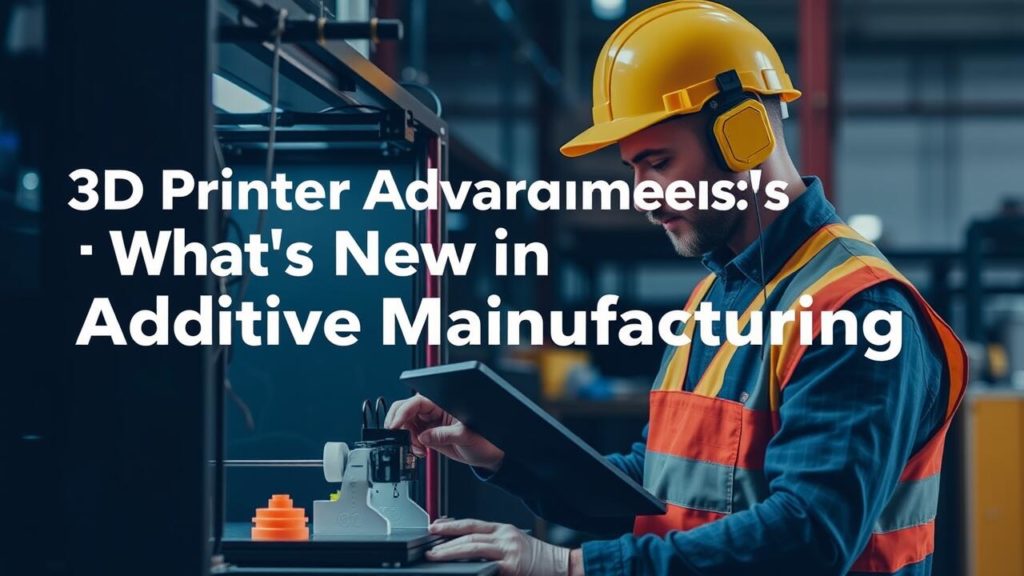Lately, a whirlwind of innovations in 3D printer hardware has radically transformed the landscape of additive manufacturing systems. With high-precision components and cutting-edge materials bursting onto the scene, we’re witnessing layer resolutions that dazzle and print speeds that sprint ahead like never before! New models are flaunting features like automatic calibration—this nifty addition slashes human error to bits and cranks up efficiency during the printing process. These leaps in technology have catapulted us into a realm where crafting intricate designs, once thought impossible with traditional methods, is now entirely within reach.
But wait, there’s more! Manufacturers are weaving smarter capabilities right into the fabric of these machines. Imagine IoT connectivity seamlessly integrated—users can now monitor and control their printers remotely, tracking progress and tweaking settings from virtually anywhere. This pivot towards automation is nothing short of revolutionary; it streamlines workflows especially in industrial environments where rapid prototyping and production reign supreme. And let’s not overlook those enhanced user interfaces—they’re simplifying operations so brilliantly that advanced features become accessible to everyone—from enthusiastic hobbyists to seasoned professionals across diverse industries!
Notable Upgrades in Printer Design and Functionality
In the whirlwind of recent printer design evolution, a remarkable focus has emerged, honing in on efficiency and accuracy like never before. Picture this: manufacturers are seamlessly weaving direct drive extruders into their creations—these ingenious components elevate filament management to new heights, granting unparalleled control over material flow. And just when you think it couldn’t get any better, enter the game-changer: multi-material printing capabilities! This groundbreaking innovation opens up an expansive universe of applications for 3D printing. Imagine blending various materials within a single print, diving into the depths of complex geometries and crafting multifunctional components that push creative boundaries.
But wait! The story doesn’t end there. Functionality is undergoing a renaissance too, courtesy of automated calibration systems that rise to prominence with astonishing speed. These clever systems vigilantly maintain print quality by executing real-time adjustments—minimizing human error during those crucial setup moments. As if that’s not enough magic for one realm, software advancements have transformed how we manage print jobs altogether; users now wield the power to monitor and control their printing processes from afar—a true marvel in convenience! These technological leaps don’t merely enhance user experience; they pave the way for producing intricately detailed and precision-engineered components across diverse industries—a testament to innovation’s relentless march forward!
| Feature | Description | Benefits |
|---|---|---|
| Direct Drive Extruders | Components that enhance filament management and control material flow. | Improved print quality and precision in complex prints. |
| Multi-Material Printing | Capability to blend various materials in a single print. | Allows for complex geometries and multifunctional components. |
| Automated Calibration Systems | Systems that maintain print quality through real-time adjustments. | Minimizes human error and improves setup efficiency. |
| Remote Print Job Management | Software advancements allowing users to control and monitor their prints from anywhere. | Enhances convenience and efficiency in print management. |
The Impact of 3D Printing on Aerospace Engineering
The aerospace sector is in the throes of a remarkable metamorphosis, all thanks to the game-changing advent of 3D printing technologies. Picture this: lightweight components that not only slash fuel consumption but also turbocharge overall efficiency. Those intricate shapes and convoluted geometries—once deemed impossible or merely fanciful dreams with traditional manufacturing—are now within reach, ushering in a new era of performance metrics for aircraft.
But wait, there’s more! Additive manufacturing isn’t just about creating parts; it’s a catalyst for rapid prototyping and design iteration that catapults development timelines into hyperspace. Engineers can dive in, test their wildest ideas, tweak designs on the fly—all while dramatically tightening the product development cycle. The accuracy and bespoke nature of 3D printing cater to an insatiable demand for customized solutions across various aerospace realms—from turbines to brackets—ensuring each component not only meets stringent performance criteria but does so while curbing waste like never before.
Streamlining Production Processes for Aircraft Components
The infusion of 3D printing technology into the realm of aerospace manufacturing has sparked a seismic shift in how aircraft components come to life. Gone are the days when production hinged on convoluted supply chains and protracted manufacturing timelines, which inevitably inflated costs and stretched lead times like taffy. Enter additive manufacturing—a game-changer that empowers aerospace firms to forge intricate parts right under their own roofs, slashing production time dramatically. This leap forward not only paves the way for more astute resource management but also curtails waste, thus refining the entire manufacturing process.
But wait—there’s more! 3D printing unlocks the potential for crafting lightweight components that turbocharge fuel efficiency and performance metrics alike. The capacity to design with complex geometries previously deemed impossible through conventional means hands engineers an exhilarating degree of creative freedom during the design phase. This isn’t just about meeting performance benchmarks; it’s a strategic advantage that bolsters compliance with regulatory stipulations by facilitating rapid prototyping and rigorous testing cycles. Consequently, we’re witnessing an extraordinary metamorphosis within the aerospace industry—one that propels productivity skyward while championing sustainability in aircraft manufacture like never before!
Customization Trends in Additive Manufacturing
The realm of additive manufacturing has undergone a remarkable transformation, now pulsating with a vibrant trend toward hyper-customization. This revolution is propelled by cutting-edge advancements in 3D printing technology, enabling the creation of designs that are not just intricate but tailored to the whims and fancies of individual consumers. Picture this: industries like healthcare and fashion leading the charge, crafting bespoke prosthetics and personalized apparel that cater to specific needs—an intersection where utility meets individuality. The magic lies in producing items that fit like a glove; such precision elevates both allure and efficacy.
But wait, there’s more! The surge in customizable options doesn’t merely satisfy preferences—it ignites consumer engagement on an unprecedented scale. Today’s shoppers crave products imbued with their personal identity, sparking a fierce demand for one-of-a-kind designs. This phenomenon isn’t just about style; it’s a catalyst for innovation among manufacturers while simultaneously weaving tighter bonds between companies and their clientele. By tapping into the treasure trove of data analytics and customer insights, businesses can craft adaptive designs that resonate deeply with market yearnings—boosting not only satisfaction but also nurturing unwavering brand loyalty along the way.
The Shift Towards Personalized Products
The surge in customization is shaking up the world of additive manufacturing like never before. Consumers are on the hunt for products that resonate with their unique desires, interests, and yes—even aesthetics. This phenomenon is particularly pronounced in industries like consumer goods, healthcare, and fashion; here, a touch of individuality can amplify user satisfaction to new heights. With 3D printing at their fingertips, manufacturers now wield a powerful tool—creating bespoke items that give them an edge over competitors by rapidly adapting to shifting consumer whims.
But wait, there’s more! The recent leaps in design software and 3D printing tech have unraveled new pathways for companies eager to churn out personalized products en masse. Think about it: innovations such as generative design paired with artificial intelligence are revolutionizing how we develop products—they allow for rapid-fire iterations based on real customer feedback. This evolution doesn’t just ramp up production efficiency; it cultivates deeper connections between brands and consumers because let’s face it—a tailored product often sparks stronger loyalty and engagement than one-size-fits-all solutions ever could.
Regulatory Changes Affecting 3D Printing
The landscape of additive manufacturing is a shifting mosaic, intricately woven by the ever-changing tapestry of regulations that aim to uphold safety and quality across a myriad of applications. As industries dive headfirst into the world of 3D printing technologies, regulatory bodies scramble to carve out comprehensive guidelines and compliance standards that can keep pace. These regulations delve deep into material safety, production processes, and quality assurance measures—vital components in sectors like aerospace and medical devices where safety isn’t just important; it’s non-negotiable. Crafting clear protocols not only ignites innovation but also serves as a bulwark against the perils lurking in non-compliance.
Moreover, the clamor for standardization is crescendoing as an increasing number of stakeholders flood into the 3D printing arena. Manufacturers, designers, engineers—they’re all on the hunt for clarity when it comes to acceptable practices and materials. The collaboration between industry titans and regulatory agencies has shifted from being beneficial to absolutely essential; together they strive to forge frameworks that deftly balance cutting-edge innovation with prudent risk management. As these standards continue their evolution, they are poised to reshape design and manufacturing processes alike—ushering in an era characterized by safer yet more efficient production methods.
Compliance and Standards in the Evolving Landscape
The whirlwind of progress in 3D printing technology has triggered a profound reassessment of compliance and regulatory standards across an array of industries. As additive manufacturing carves its niche—particularly within the realms of aerospace and healthcare—the urgency for well-defined guidelines becomes strikingly evident. Regulatory bodies are laboring tirelessly, crafting frameworks that guarantee the safety, reliability, and quality of 3D printed products. These emerging guidelines seek to tackle a multitude of concerns: material properties, production processes, and even the very capabilities inherent to this groundbreaking technology—all aimed at cultivating a richer understanding among both manufacturers and consumers.
In reaction to this rapidly shifting technological landscape, industry standards organizations are aligning their efforts in pursuit of comprehensive best practices. Such standards aim to forge a common lexicon among varied stakeholders—manufacturers, auditors, regulatory officials—effectively trimming away ambiguity while bolstering product validation processes. As time marches on and the world of additive manufacturing evolves into maturity, establishing clear compliance metrics will prove vital—not only for spurring innovation but also for protecting public interests and maintaining industrial integrity amidst this transformative wave.
- Establish clear material specifications and testing protocols to ensure consistent quality
- Implement risk assessment frameworks for evaluating the safety of 3D printed products
- Develop a standardized documentation process for traceability and accountability
- Create educational programs to enhance understanding of compliance requirements within the industry
- Foster collaboration between regulatory bodies, manufacturers, and technology developers to streamline standards
- Regularly update guidelines to keep pace with technological advancements and emerging challenges
- Promote transparency in compliance processes to build consumer trust and confidence in 3D printed products
Future Prospects for 3D Printing Technology
The future of 3D printing technology is on the brink of an exhilarating transformation, propelled by relentless strides in materials and processes. Researchers are diving into a sea of avant-garde polymers and metals, each promising to boost durability and functionality, thus broadening the horizon for applications across a kaleidoscope of industries. Meanwhile, the infusion of artificial intelligence and machine learning is revolutionizing design workflows—optimizing processes like never before—while simultaneously trimming costs and accelerating time to market.
As additive manufacturing gathers momentum like a snowball rolling downhill, we can anticipate a surge in investments aimed at fortifying infrastructure and spurring development. This burgeoning trend is poised to catalyze wider adoption of 3D printing in realms such as healthcare, automotive engineering, and consumer goods. Companies are boldly setting their sights high with ambitious production scalability goals; they’re envisioning on-demand manufacturing systems crafted to cater uniquely to individual consumer needs. The intersection where 3D printing meets emerging technologies promises an explosion of innovative solutions capable of tackling challenges that span multiple sectors—ultimately reshaping the very fabric of our manufacturing landscape.
Predictions for the Next Decade in Additive Manufacturing
The coming decade is set to unfold a tapestry of dramatic transformations in the realm of additive manufacturing technologies. Picture this: advanced materials taking center stage, with biocompatible wonders and featherlight composites entering the spotlight. A whirlwind of innovation will sweep through printing methodologies—think hybrid techniques that elegantly meld additive and subtractive processes, pushing the boundaries of efficiency and precision to new heights. As digital fabrication strides into the mainstream, organizations will pivot towards increasingly automated production processes, slashing lead times in their wake.
Customization? Oh, it’s not just a trend; it’s an unstoppable force driving industry evolution. The capacity to sculpt products tailored not only for personal tastes but also for niche applications will unveil fresh market vistas brimming with opportunity. With artificial intelligence and machine learning weaving themselves into 3D printing workflows, we can expect design optimizations that are nothing short of revolutionary. And let’s not overlook sustainability—a rising tide that compels the creation of eco-friendly materials and practices, ensuring that additive manufacturing evolves hand-in-hand with global environmental ambitions. Exciting times lie ahead!
Conclusion
The whirlwind of advancements in 3D printing technology reveals a landscape ripe with transformative potential, sprawling across an array of industries. With printer hardware evolving at breakneck speed and design capabilities blossoming like spring flowers, the horizons of additive manufacturing are stretching wider by the day. This metamorphosis fuels innovation in realms such as aerospace, where streamlined production methods not only heighten efficiency but also slice through costs like a hot knife through butter. The surging demand for customization signals a pivotal shift towards bespoke manufacturing solutions—tailored to meet the eclectic needs of consumers and businesses alike.
But wait! Regulatory changes loom on the horizon, poised to dramatically influence the trajectory of 3D printing’s future. As standards morph and adapt, navigating compliance will become an essential dance for industry players. Peering into the crystal ball, the next decade brims with tantalizing possibilities for additive manufacturing. A steady stream of research and development promises to unleash fresh applications while fine-tuning existing processes—further weaving 3D printing into the very fabric of contemporary manufacturing practices.


